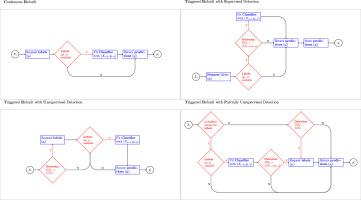Structuring the processing frameworks for data stream evaluation and application
IF 7.6
1区 计算机科学
Q1 COMPUTER SCIENCE, ARTIFICIAL INTELLIGENCE
引用次数: 0
Abstract
The following work addresses the problem of frameworks for data stream processing that can be used to evaluate the solutions in an environment that resembles real-world applications. The definition of structured frameworks stems from the need to reliably assess data stream classification methods, considering the constraints of delayed label access, the costs of their acquisition and the costs of model adaptation. The current experimental evaluation often boundlessly exploits the assumption of the immediate label access to monitor the recognition quality and adapt the methods to the changing concepts. The problem is leveraged by reviewing currently described methods and techniques for data stream processing and verifying their outcomes in simulated environment. This work defines a taxonomy of data stream processing frameworks and presents four processing schemes that link the tasks of drift detection and classification while considering a natural phenomenon of label delay. The presented research shows that classification quality is significantly affected not only by the disruptive phenomenon of concept drifts and label delay, but also by the undertaken processing scheme that describes the flow of labels in the recognition system. Considering a specific processing framework depending on real-world constraints proves to be a critical aspect of reliable and realistic experimental evaluation.

构建数据流评估和应用的处理框架
下面的工作解决了数据流处理框架的问题,该框架可用于评估类似于实际应用程序的环境中的解决方案。结构化框架的定义源于可靠地评估数据流分类方法的需要,考虑延迟标签访问的约束、获取标签的成本和模型适应的成本。目前的实验评估往往无限地利用即时标签访问的假设来监控识别质量,并使方法适应不断变化的概念。通过回顾当前描述的数据流处理方法和技术,并在模拟环境中验证其结果,可以利用该问题。这项工作定义了数据流处理框架的分类,并提出了四种处理方案,这些方案将漂移检测和分类任务联系起来,同时考虑到标签延迟的自然现象。本研究表明,分类质量不仅受到概念漂移和标签延迟等破坏性现象的显著影响,而且还受到描述识别系统中标签流的处理方案的显著影响。考虑一个具体的处理框架取决于现实世界的约束被证明是可靠和现实的实验评估的一个关键方面。
本文章由计算机程序翻译,如有差异,请以英文原文为准。
求助全文
约1分钟内获得全文
求助全文
来源期刊

Pattern Recognition
工程技术-工程:电子与电气
CiteScore
14.40
自引率
16.20%
发文量
683
审稿时长
5.6 months
期刊介绍:
The field of Pattern Recognition is both mature and rapidly evolving, playing a crucial role in various related fields such as computer vision, image processing, text analysis, and neural networks. It closely intersects with machine learning and is being applied in emerging areas like biometrics, bioinformatics, multimedia data analysis, and data science. The journal Pattern Recognition, established half a century ago during the early days of computer science, has since grown significantly in scope and influence.
 求助内容:
求助内容: 应助结果提醒方式:
应助结果提醒方式:


